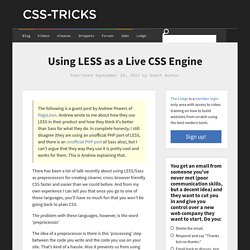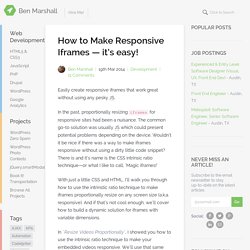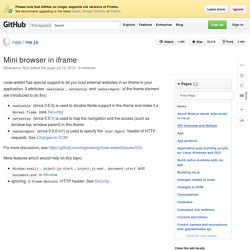

Using LESS as a Live CSS Engine. The following is a guest post by Andrew Powers of PageLines.

Andrew wrote to me about how they use LESS in their product and how they think it's better than Sass for what they do. In complete honesty, I still disagree (they are using an unofficial PHP port of LESS, and there is an unofficial PHP port of Sass also), but I can't argue that they way they use it is pretty cool and works for them. This is Andrew explaining that. There has been a lot of talk recently about using LESS/Sass as preprocessors for creating cleaner, cross-browser friendly CSS faster and easier than we could before.
And from my own experience I can tell you that once you go to one of these languages, you’ll have so much fun that you won’t be going back to plain CSS. The problem with these languages, however, is the word ‘preprocessor.’ The idea of a preprocessor is there is this ‘processing’ step between the code you write and the code you use on your site. About PageLines Use Case Why LESS for Live Processing? Results. Post Data to an iframe. Jquery.iframe-transport.js. jQuery AJAX Form Submit Example. In jQuery AJAX Form Submit Example, I have explained how to submit a HTML Form asynchronously using jQuery AJAX API.

Topics Covered: 1).Submit a Simple HTML Form 2).Submit Multipart/form-data Form. jQuery AJAX Form Submission with IFrames. One problem I've come along with creating an AJAX application that works with Symfony2 or any time you need to upload a file is that you need to target an IFrame in order to keep the user on the same page.

Jquery - How to make Asynchronous(AJAX) File Upload using iframe? Posting a form via AJAX through a hidden iFrame. This is necessary when uploading an image using ajax for IE < 10. It is also useful in other cases, where your post endpoint cannot easily digest JSON, for instance. Responsive Iframes — yes it is possible. The Web has always had a love-hate relationship with 3rd-party content.

Whether that external content is self-contained functionality brought into a website via SaaS, or to add a donation form to your website in a way that reduces your PCI Requirements, or to possibly connect your disparate web properties together. Back in the prehistoric days before responsive web development (a.k.a. two years ago) a common way to insert 3rd-party content was with an iframe. Something like: The challenge with responsive design is the hard-coded width and height. You might be able to choose reasonable settings for a desktop viewport, but a smaller mobile viewport may require something narrower and longer (or sometimes even wider and shorter).
How to Make Responsive Iframes — it's easy! Easily create responsive iframes that work great without using any pesky JS.

In the past, proportionally resizing iframes for responsive sites had been a nuisance. The common go-to solution was usually JS which could present potential problems depending on the device. Wouldn’t it be nice if there was a way to make iframes responsive without using a dirty little code snippet? There is and it’s name is the CSS intrinsic ratio technique—or what I like to call, ‘Magic iframes!’ Making Embedded Content Work In Responsive Design. About The Author Rachel is a freelance web designer and writer specialising in mobile and responsive WordPress development. She’s the author of ‘Mobile WordPress … More about Rachel McCollin … A few HTML elements don’t play nice with responsive layouts. One of these is the good ol’ iframe, which you may need to use when embedding content from external sources such as YouTube.
In this article, we’ll show you how to make embedded content responsive using CSS, so that content such as video and calendars resize with the browser’s viewport. A few HTML elements don’t play nice with responsive layouts. In this article, we’ll show you how to make embedded content responsive using CSS, so that content such as video and calendars resize with the browser’s viewport. Further Reading on SmashingMag: Note: This technique was originally detailed in Thierry Koblenz’s excellent tutorial ‘Creating Intrinsic Ratios for Video’.
The Markup For Embedded Content. Mini browser in iframe · nwjs/nw.js Wiki. Node-webkit has special support to let you load external websites in an iframe in your application. 3 attributes nwdisable, nwfaketop and nwUserAgent of the iframe element are introduced to do this: nwdisable (since 0.5.0) is used to disable Node support in the iframe and make it a Normal frame (see Security)nwfaketop (since 0.5.1) is used to trap the navigation and the access (such as window.top, window.parent) in this iframe.nwUserAgent (since 0.9.0-rc1) is used to specify the User-Agent header of HTTP requests.

See Changes-to-DOM For more discussion, see More features which would help on this topic: Express Node.JS render an html page and then send it back to an iframe. Node-webkit iframe access to parent nw function.